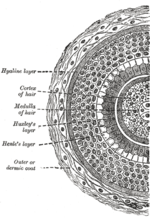Pelycosaur (/ˈpɛlɪkəˌsɔːr/ PEL-ih-kə-sor) is an older term for basal or primitive Late Paleozoic synapsids, excluding the therapsids and their descendants...
12 KB (1,185 words) - 17:32, 30 August 2024
This list of pelycosaurs is an attempt to create a comprehensive listing of all genera that have ever been included in the synapsida excluding therapsida...
33 KB (1,723 words) - 22:12, 26 September 2023
systematics, and non-therapsid synapsids were also referred to as pelycosaurs, or pelycosaur-grade synapsids. These paraphyletic terms have now fallen out...
57 KB (5,746 words) - 21:05, 25 September 2024
commonly called "pelycosaurs", specifically within the Sphenacodontia, more than 279.5 million years ago. They replaced the pelycosaurs as the dominant...
30 KB (2,935 words) - 20:50, 28 September 2024
glaciation. Hot and dry climate. A possible drop in oxygen levels. Synapsids (pelycosaurs and therapsids) become widespread and dominant, while parareptiles and...
174 KB (9,789 words) - 10:34, 9 October 2024
from a "pelycosaur" ancestor (a poorly defined group including all synapsids which are not therapsids). The therapsid takeover from pelycosaurs took place...
76 KB (9,092 words) - 00:04, 2 October 2024
(Cisuralian) saw a major faunal turnover, with most lineages of primitive "pelycosaur" synapsids becoming extinct, being replaced by more advanced therapsids...
115 KB (11,882 words) - 19:46, 27 September 2024
the earliest sauropsid reptiles (Hylonomus), and the earliest known "pelycosaur" synapsids (Archaeothyris). Small lizard-like animals quickly gave rise...
14 KB (1,149 words) - 19:36, 27 September 2024
Comparison of cheek teeth in various taxa: 1, a single-cusped pelycosaur; 2, Dromatherium (a Triassic cynodont); 3, Microconodon (a Triassic eucynodont);...
18 KB (1,919 words) - 00:16, 29 April 2024
constitutes the larger Amniota clade. Early synapsids are referred to as "pelycosaurs." The more advanced therapsids became dominant during the Guadalupian...
222 KB (23,103 words) - 19:04, 29 September 2024
faunas were dominated by pelycosaurs (a paraphyletic group of early synapsids), diadectids, and temnospondyls, The pelycosaurs appeared during the Late...
19 KB (1,632 words) - 19:41, 27 September 2024
37 (13): 385–401. Sternberg, C.W. (1942). "The skeleton of an immature pelycosaur, Dimetrodon cf. grandis, from the Permian of Texas". Journal of Paleontology...
83 KB (9,217 words) - 18:08, 1 October 2024
groups, synapsids and sauropsids, date from around 313 Ma. The synapsid pelycosaurs and their descendants the therapsids are the most common land vertebrates...
234 KB (22,713 words) - 19:23, 14 September 2024
(reptiles, including dinosaurs and therefore birds) and synapsids (extinct pelycosaurs, therapsids and all extant mammals, including humans). Some tetrapods...
104 KB (10,592 words) - 17:52, 1 October 2024
evidence for soft tissues. Skin impression of the belly and lower tail of a pelycosaur, possibly Haptodus shows the basal synapsid stock bore transverse rows...
74 KB (8,458 words) - 20:20, 28 September 2024
body temperature of the animal, in a similar way to the sails of the pelycosaurs Dimetrodon and Edaphosaurus (and modern elephant and rabbit ears). The...
101 KB (12,175 words) - 18:08, 10 October 2024
This list of nicknamed non-dinosaur fossils is a list of non-dinosaurian fossil specimens given informal names or nicknames, in addition to their institutional...
66 KB (3,454 words) - 05:15, 4 September 2024
originally considered a suborder of pelycosaurs or "mammal like reptiles", but it was redefined in 1997, and the term pelycosaur itself has fallen into disfavor...
10 KB (775 words) - 08:41, 6 October 2024
birds) and synapsids (including mammals and extinct ancestors like "pelycosaurs" and therapsids), an event that marks the appearance of Amniota, according...
48 KB (3,794 words) - 19:35, 7 October 2024
characteristics (e.g. no secondary palate, small dentary) shared with their pelycosaur ancestors, although they are also more advanced in possessing therapsid...
11 KB (918 words) - 22:37, 28 August 2024
temnospondyl amphibians and pelycosaurs (e.g. Dimetrodon) diversify in species. 275 Ma Therapsid synapsids separate from pelycosaur synapsids. 265 Ma Gorgonopsians...
85 KB (4,733 words) - 00:11, 13 September 2024
and chelonia (turtles and relatives) Synapsida – one low fenestra – pelycosaurs and therapsids (the 'mammal-like reptiles') Euryapsida – one high fenestra...
138 KB (14,814 words) - 04:05, 4 October 2024
publication of two of the best-known fossil taxa described by Cope: the pelycosaur Edaphosaurus in 1882 and the early dinosaur Coelophysis in 1889. In 1889...
75 KB (9,433 words) - 13:37, 7 October 2024
Assemblage Zone is the youngest known varanopid and the last member of the "pelycosaur" group of synapsids. No known varanopids developed a sail like Dimetrodon...
15 KB (1,513 words) - 02:09, 21 September 2024
Comparison of cheek teeth in various taxa: 1, a single-cusped pelycosaur; 2, Dromatherium (a Triassic cynodont); 3, Microconodon (a Triassic eucynodont);...
4 KB (511 words) - 16:06, 22 January 2024
many respects, the pelycosaurs are intermediate between the reptiles and mammals" http://www.ucmp.berkeley.edu/synapsids/pelycosaurs.html Berkeley University...
87 KB (3,541 words) - 02:48, 4 September 2024
diversified into a number of groups, including several families of synapsid pelycosaurs, protorothyridids, captorhinids, saurians and araeoscelids. The amphibian-like...
114 KB (11,979 words) - 20:55, 8 October 2024
are now thought to have separately evolved from diapsid ancestors). Pelycosaurs died out before the end of the Permian. Too few Permian diapsid fossils...
365 KB (39,182 words) - 13:25, 24 September 2024
large, advanced, carnivorous, Late Pennsylvanian to middle Permian "pelycosaurs". The most recent one, Dimetrodon angelensis, is from the latest Kungurian...
8 KB (694 words) - 21:49, 4 January 2024
Pennsylvanian and Cisuralian evolutionary radiation (often still called "pelycosaurs", though this is a paraphyletic group) by therapsids occurred around...
147 KB (15,027 words) - 23:14, 10 October 2024























